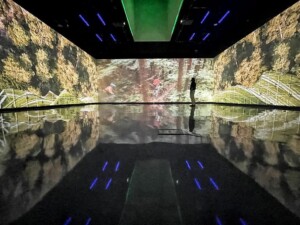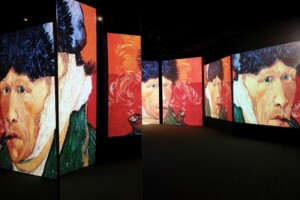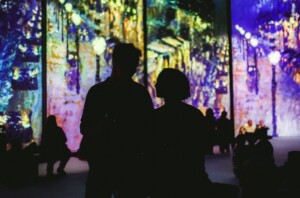In the world of manufacturing, where efficiency is king, the idea of craftsmanship may seem a relic from the past. However, one Japanese tradition is bridging the gap between artisanal and mass-produced: the Takumi system. And the companies adopting it are adding real value to the entertainment industry and beyond.
But what is a Takumi? Takumi refers to individuals who have spent at least 60,000 hours honing a specific skill to become masters of their craft. A woodworking Takumi might spend a lifetime specializing in the use of a single tool, for example. Within large organizations, Takumi usually take on the role of line designers, team leaders and quality control supervisors. They can also be educators that pass on knowledge.
“The essence of Takumi is to gain a sublime understanding of the nuances of a particular art,” says Nahoko Kojima. Kojima is a paper-cut artist who appears in the documentary A 60,000 Hour Story of the Survival of Human Craft. “To be focused and spend countless hours on one thing, and to carry on. It requires one to empty the mind and focus in a way that is simply not possible when still acquiring a skill.”
What value does the Takumi system provide?
There are many advantages to applying the Takumi system for businesses and their customers. A study by Japan Productivity Center has shown that companies implementing the Takumi system experienced a 15% increase in productivity. They also saw a 20% decrease in product defects. Similar research from the University of Tokyo found a 30% reduction in manufacturing costs. Meanwhile, another study from the Massachusetts Institute of Technology measured a 50% improvement in product quality.
While the Takumi system benefits the organization and its customers, the advantages also flow downstream. By using sustainable projectors, attraction operators contribute to the industry by meeting guest expectations for repeatable experiences. Guests are less likely to recommend an experience to friends and family if they can’t be confident the quality will be the same every time.
The Takumi system at Panasonic Connect
As well as being an adherent to the Takumi system, Panasonic Connect is unique among its peers for its commitment to in-house manufacturing. With the exception of DMD chips, supplied by Texas Instruments (TI), and laser diodes, the firm makes other remaining components of its projectors in-house.
While the investment cost of this approach is high, greater control has dramatically improved supply chain management, quality assurance, device reliability, and the projector’s ability to deliver immersive storytelling that captivates guests with overwhelming visuals.
How the Takumi system works
The Takumi system at Panasonic Connect goes beyond hand-building its high-end projector models. A single Takumi designs the manufacturing process which is then implemented by the Takumi responsible for each stage of production. Each product consists of thousands of components. Throughout the assembly process, there are rigorous quality control checks during each phase.
“Good manufacturing is achieved only through the combination of good design, good technicians, and good equipment,” says the Plant Technology Takumi at the Panasonic Connect Kadoma factory in Osaka. This facility produces around 5,000 projectors annually, including the company’s PT-RQ50K flagship. “My role is to link these three resources in the best way possible.”
These capabilities can only be gained through time investment, and Takumi’s knowledge cannot be replicated by machines. And much of the expertise in understanding the technical processes is all inside the Takumi’s head.
“[Optical assembly] is a process whose output quality can be determined only through the hands and eyes,” says one of the Optical Component Takumis at Panasonic Connect. “We cannot put the process entirely in the hands of machines.”
One of the Final Inspection Takumis agrees. “My strength lies in the skills I cultivated through many years of experience inspecting a very large number of products. In particular, inspecting the tint of projected images requires a sensory assessment. The criteria for detecting defects are only in my mind.
“The final inspection involves checking the images for tint and focus flaws as well as the possible misalignment of pixels,” she continues. “We cannot allow products to have microscopic dust or a defect, even in a single pixel. A failure to detect minor defects can have a direct negative impact on customers. I consider myself the last line of defence.”
Meeting the need for absolute reliability
Takumi’s insistence on perfection results in the stability that is vital in any media-based application. Particularly events broadcast on network TV. In the age of social media, hashtags rule, and people aren’t shy about publicly venting their frustrations. So, interruption to any media-based experience can be disastrous. With its emphasis on quality control and testing, the Takumi system provides peace of mind for operators of year-round attractions or high-profile special public events.
Some recent proof of this was at an outdoor projection-mapping spectacular at Budapest’s Buda Castle and Parliament Building. This was held on Hungary’s national foundation holiday in 2021. The event attracted 700,000 spectators and more watched the broadcast on national TV. It used 50x Panasonic 3-Chip DLP projectors connected by some 200 km of cabling to illuminate the castle’s facade.
When it came to selecting projectors for the task, reliability was the top priority for the production company. One of our key production company customers commented:
“Reliability and image quality were only available on Panasonic projectors with this amount of special long optics. This also makes it clear that rental companies also like to work with these projectors.”
It’s also easy to see the importance of reliability when your entertainment takes place in the middle of the ocean. Projectors power the entertainment aboard The Celebrity Edge cruise ship based on their track record of reliability.
Back on dry land, digital museums such as the D-Day Museum in France also depend heavily on projectors. This attraction is unique in the way it combines the physical location with digital content. A projection is superimposed over a window looking out on the ocean using a transparent holographic canvas. This allows visitors to see history unfolding before them as if in real life.
As a centrepiece attraction at the museum, reliability was the main criterion for projector selection.
Securing the future
At a time when the entertainment experience holds tremendous value for many stakeholders, Takumi craftspeople and their innovations continue to play a pivotal role. Projector reliability is the key to delivering repeatability. This is crucial for meeting guest expectations for unforgettable experiences every time without fail.
To find out more about professional projectors and the ecosystem of co-creative tech partner services offered by Panasonic Connect, please please click here or contact Chad Kunimoto via email.











